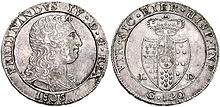
The piastra was the distinct currency of the Kingdom of Sicily until 1815.

The piastra was the distinct currency of the Kingdom of Sicily until 1815.
In order to distinguish it from the piastra issued on the mainland Kingdom of Sicily (also known as the Kingdom of Naples), it is referred to as the "Sicilian piastra" as opposed to the "Neapolitan piastra". These two piastra were equal, but were subdivided differently. The Sicilian piastra was subdivided into 12 tarì , each of 20 grana or 120 piccoli. The oncia was worth 30 tarì (2+1⁄2 piastre).
In 1815, a single piastra currency was introduced for the Kingdom of the Two Sicilies, the Two Sicilies piastra.
In the late 18th century, coins were circulating in denominations of 3 piccoli, 1, 2, 10 and 20 grana, 2, 3, 4 and 6 tari, 1 piastra and 1 oncia. These were struck in copper up to the 2 grana, with the higher denominations in silver. In 1801, copper 5 and 10 grana were introduced, followed by a gold 2 oncia in 1814.
Following the adoption of the unified currency for the two Sicilies, copper coins were issued in 1835 and 1836 bearing the name "Siciliana", in denominations of ½, 1, 2, 5 and 10 grana. It is unclear whether these coins were denominated in Two Sicilies grana or the old Sicilian grano (worth half as much).
From a Riveli in 1607 Catania, also a Riveli in 1811 Avola, the Sicilian money system can be readily extracted. It was:-
On both of these historic documents, the denomination piastra was not used. A Sicilian coin commonly available for sale today is the 120 grana silver piece, weighing an ounce. It is called, in the supplementary description of this silver piece, one piastra. However, in 1823 George Crabb, in his Universal Technological Dictionary Volume 2, in addition to supporting the above relative values of onze, tarì and grano in accounting, lists 120 grana as equivalent to one fiorino. Crabb also lists the ponto, the carlino, the ducat and the scudo or crown and their equivalence to the grano, however no mention of the piastre.

The svenska riksdaler was the name of a Swedish coin first minted in 1604. Between 1777 and 1873, it was the currency of Sweden. The daler, like the dollar, was named after the German Thaler. The similarly named Reichsthaler, rijksdaalder, and rigsdaler were used in Germany and Austria-Hungary, the Netherlands, and Denmark-Norway, respectively. Riksdaler is still used as a colloquial term for krona, Sweden's modern-day currency.

Kuruş, also gurush, ersh, gersh, grush, grosha, and grosi, are all names for currency denominations in and around the territories formerly part of the Ottoman Empire. The variation in the name stems from the different languages it is used in and the different transcriptions into the Latin alphabet. In European languages, the kuruş was known as the piastre.

The lira was the currency of Italy between 1861 and 2002. It was introduced by the Napoleonic Kingdom of Italy in 1807 at par with the French franc, and was subsequently adopted by the different states that would eventually form the Kingdom of Italy in 1861. It was subdivided into 100 centesimi, which means "hundredths" or "cents". The lira was also the currency of the Albanian Kingdom from 1941 to 1943.

A non-decimal currency is a currency that has sub-units that are a non-decimal fraction of the main unit, i.e. the number of sub-units in a main unit is not a power of 10. Historically, most currencies were non-decimal, though today virtually all are now decimal.
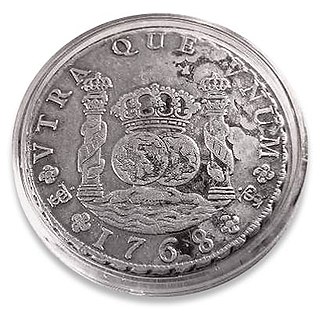
The real was a unit of currency in Spain for several centuries after the mid-14th century. It underwent several changes in value relative to other units throughout its lifetime until it was replaced by the peseta in 1868. The most common denomination for the currency was the silver eight-realSpanish dollar or peso which was used throughout Europe, America and Asia during the height of the Spanish Empire.

The scudo is the official currency of the Sovereign Military Order of Malta and was the currency of Malta during the rule of the Order over Malta, which ended in 1798. It is subdivided into 12 tarì, each of 20 grani with 6 piccioli to the grano. It is pegged to the euro.

The rixdollar was the currency of British Ceylon until 1828. It was subdivided into 48 stivers, each of 4 duit. Units called the fanam and larin were also used, worth 4 and 9½ stiver, respectively. The currency derived from the Dutch rijksdaalder and stuiver, although the rijksdaalder was worth 50 stuiver.

The piastre de commerce was the currency of French Indochina between 1887 and 1954. It was first used in 1885. It was subdivided into 100 cents, each of 2~6 sapèques.

The franc was the currency of Cambodia between 1875 and 1885. It was equal to the French franc and was similarly subdivided into 100 centimes. It circulated alongside the piastre with 1 piastre = 5.37 francs. It replaced the tical and was replaced by the piastre. No paper money was issued.
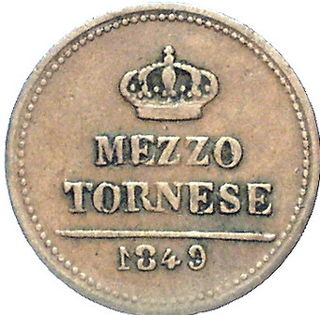
The ducat was the main currency of the Kingdom of the Two Sicilies between 1816 and 1860. When the Congress of Vienna created the kingdom merging the Kingdom of Naples and the Kingdom of Sicily, the ducat became at par a continuation of the Neapolitan ducat and the Sicilian piastra issued prior to 1816, although the Sicilian piastra had been subdivided into 240 grana. In the mainland part of the kingdom, the ducat also replaced the Napoleonic lira.

The rial or piastre was the currency of Tunisia until 1891. It was subdivided into 16 kharub, each of 13 fals. The fals was further subdivided into 6 qafsi. The nasri was worth 2 fals. The denomination was often either not given on coins or only indicated by a numeral. Some rial denominated coins have a numeral over the Arabic letter r, ر.
The lira was the distinct currency of Venice until 1848, when it was replaced by the Italian lira. It originated from the Carolingian monetary system used in much of Western Europe since the 8th century CE, with the lira subdivided into 20 soldi, each of 12 denari.
The piastra was the most common silver coin of the mainland Kingdom of Sicily, also known as the Kingdom of Naples.
The lira was the currency of the mainland part of the Kingdom of the Two Sicilies, known as the Kingdom of Naples, between 1812 and 1813.
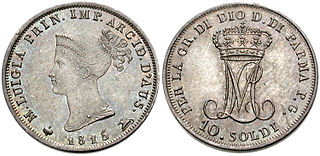
The lira was the distinct currency of Parma before 1802 and again from 1815 to 1859.
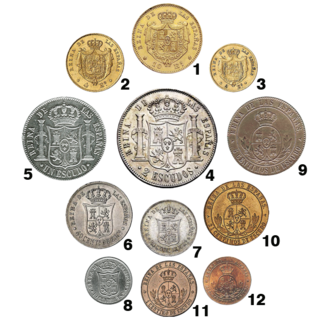
The escudo was either of two distinct Spanish currency denominations.

The rigsdaler specie was a unit of silver currency used in Norway from 1544, renamed as the speciedaler in 1816 and used until 1873. Norway used a common reichsthaler currency system shared with Denmark, Hamburg and Schleswig-Holstein until 1873 when the gold standard was implemented in Scandinavia and the German Empire.

Between 1878 and 1885, the Cochinchina piastre was the currency of the French colony of Cochinchina. It was replaced by the French Indochinese piastre after the creation of a unified administration for Cochinchina and the other French protectorates and colonies in the Far East on 22 December 1885.
The scudo was the currency of the island Kingdom of Sardinia until 1816.
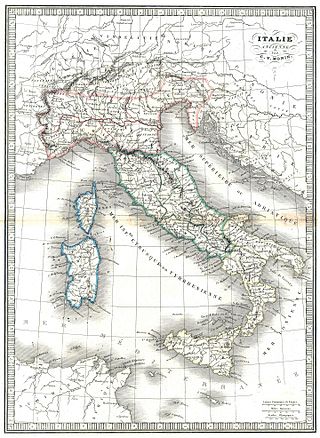
Italy has a long history of different coinage types, which spans thousands of years. Italy has been influential at a coinage point of view: the medieval Florentine florin, one of the most used coinage types in European history and one of the most important coins in Western history, was struck in Florence in the 13th century, while the Venetian sequin, minted from 1284 to 1797, was the most prestigious gold coin in circulation in the commercial centers of the Mediterranean Sea.